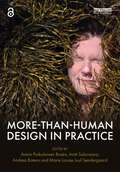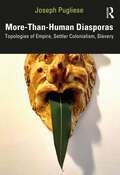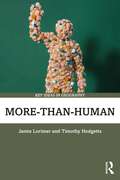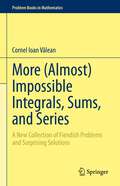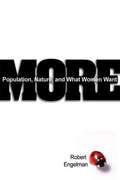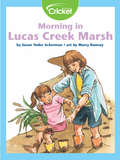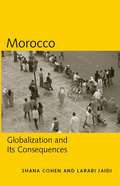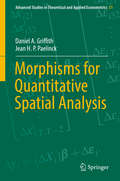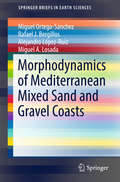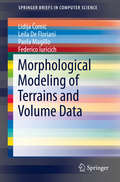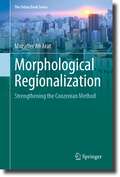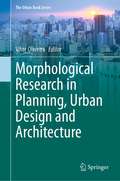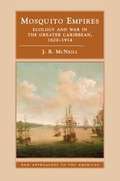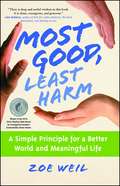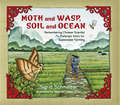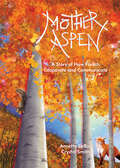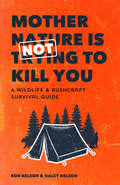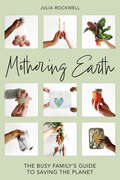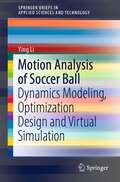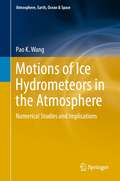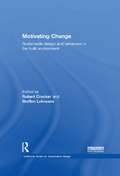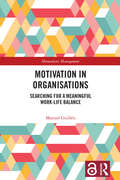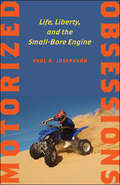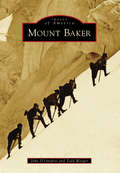- Table View
- List View
More-Than-Human Design in Practice
by Anton Poikolainen Rosén Antti Salovaara Andrea Botero Juul Søndergaard, Marie LouiseThis book provides an overview of the diverse multidisciplinary field of more-than-human design, offering a philosophical grounding of more-than-human design in posthumanism while putting practical design examples and methods to the forefront.There is an urgent need to radically re-imagine design, as its current processes are contributing to global warming, pollution, deforestation, ocean acidification, ozone layer depletion, loss of biodiversity and species extinction. Given this need, ‘more-than-human design’ has emerged as a perspective that widens our thinking beyond solely human-oriented considerations and needs, such as animals, plants and microbes. The book explores the relationship between sustainability and design, touching on topics such as AI, systems thinking, futures studies and pedagogy, and discusses a range of case study projects that are grounded in more-than-human thinking, demonstrating how this can be incorporated into practice.This easily accessible and theoretically grounded book will provide design researchers and educators an excellent introduction to more-than-human thinking. It will also be of interest to students and scholars studying design more broadly, sustainability, environmental studies and service design, as well as to practicing designers interested in sustainability.Chapters Introduction, 7, 10 and 15 of this book are freely available as a downloadable Open Access PDF at http://www.taylorfrancis.com under a Creative Commons Attribution-Non Commercial-No Derivatives (CC-BY-NC-ND) 4.0 license.
More-Than-Human Diasporas: Topologies of Empire, Settler Colonialism, Slavery
by Joseph PugliesePugliese’s More‑Than‑Human Diasporas breaks the confines of existing scholarship in its vision of the way that more‑than‑human diasporic entities—such as water, trees, clay, stone and architectural styles—have functioned as agents within the context of empire, settler colonialism and a largely effaced history of Mediterranean enslavement, a history that pre‑existed and then coincided with the Atlantic slave trade. This book traces, for example, the diasporic travels of the eucalyptus from Indigenous Country to Joseph Banks’ botanical collection in London and then onto a grand English‑style garden in Southern Italy which was built on the historically effaced labour of enslaved people.By deploying techniques of historical recovery, this book brings to light otherwise buried histories, thereby demonstrating the pivotal role of Mediterranean enslavement in the shaping of Italian society and culture. This book develops a topological understanding of cultural history to account for the complex spatio‑temporal effects that connect seemingly disparate times, spaces and more‑than‑human entities within networks of relationality. In this innovative scholarly work, more‑than‑human diasporic entities function as conceptual keys to histories which would otherwise remain hidden, thereby revealing desubjugated knowledges which reconfigure anthropocentric histories and further the process of decolonisation.This book will be of interest to readers interested in transnational and local histories of empire, settler colonialism and slavery.
More-than-Human (ISSN)
by Jamie Lorimer Timothy HodgettsThis text offers the first book-length introduction to more-than-human geography, exploring its key ideas, main debates, and future prospects.An opening chapter traces the origins and emergence of this field of enquiry and positions more-than-human geography as a response to a set of intellectual and political crises in Western thought and politics. It identifies key literatures and thinkers and reflects on the varying usages and meanings of the idea of the more-than-human. Three subsequent sections explore cross-cutting themes that draw together the disparate strands of more-than-human geography: examining new materialisms developed in the field, analysing knowledge practices and methodologies, and finally reflecting on the political and ethical implications of a more-than-human approach. A final chapter examines the tensions between this approach and cognate work in environmental geography to review the strengths and the limitations of more-than-human geographies, and to speculate as to their near future development.Introducing the key idea of more-than-human geography, this book will be an important resource for undergraduate and postgraduate students of human geography, environmental geography, cultural and social geography, and political geography.
More: A New Collection of Fiendish Problems and Surprising Solutions (Problem Books in Mathematics)
by Cornel Ioan VăleanThis book, the much-anticipated sequel to (Almost) Impossible, Integrals, Sums, and Series, presents a whole new collection of challenging problems and solutions that are not commonly found in classical textbooks. As in the author’s previous book, these fascinating mathematical problems are shown in new and engaging ways, and illustrate the connections between integrals, sums, and series, many of which involve zeta functions, harmonic series, polylogarithms, and various other special functions and constants. Throughout the book, the reader will find both classical and new problems, with numerous original problems and solutions coming from the personal research of the author. Classical problems are shown in a fresh light, with new, surprising or unconventional ways of obtaining the desired results devised by the author. This book is accessible to readers with a good knowledge of calculus, from undergraduate students to researchers. It will appeal to all mathematical puzzlers who love a good integral or series and aren’t afraid of a challenge.
More: Population, Nature and What Women Want
by Robert EngelmanIn the capital of Ghana, a teenager nicknamed "Condom Sister" trolls the streets to educate other young people about contraception. Her work and her own aspirations point to a remarkable shift not only in the West African nation, where just a few decades ago women had nearly seven children on average, but around the globe. While world population continues to grow, family size keeps dropping in countries as diverse as Switzerland and South Africa. The phenomenon has some lamenting the imminent extinction of humanity, while others warn that our numbers will soon outgrow the planet's resources. Robert Engelman offers a decidedly different vision--one that celebrates womens' widespread desire for smaller families. Mothers aren't seeking more children, he argues, but more for their children. If they're able to realize their intentions, we just might suffer less climate change, hunger, and disease, not to mention sky-high housing costs and infuriating traffic jams. In More, Engelman shows that this three-way dance between population, womens' autonomy, and the natural world is as old as humanity itself. He traces pivotal developments in our history that set population--and society--on its current trajectory, from hominids' first steps on two feet to the persecution of 'witches' in Europe to the creation of modern contraception. Both personal and sweeping, More explores how population growth has shaped modern civilization --and humanity as we know it. The result is a mind-stretching exploration of parenthood, sex, and culture through the ages. Yet for all its fascinating historical detail, More is primarily about the choices we face today. Whether society supports women to have children when and only when they choose to will not only shape their lives, but the world all our children will inherit.
Morning in Lucas Creek Marsh
by Susan Yoder AckermanThomas, Madeline, and their mother go on a walk through a Virginia tidewater marsh, spotting all kinds of wildlife along the way.
Morocco: Globalization and Its Consequences (Global Realities #Vol. 6)
by Shana Cohen Larabi JaidiCohen and Jaidi trace the development of contemporary Morocco in the Islamic world of North Africa, which is currently at the forefront of the clash between Western-style development and the politicized Islam that now pervades the Arab world. By applying globalization theory to detailed accounts of everyday life in an Arab society, the book is uniquely suited to students. Morocco in particular is a good place to look at this extremely important confrontation. It is among the most liberalized Islamic states, yet it is also in the midst of a revival of politicized Islam, which has its own globalizing agenda. The authors detail how this clash pervades Moroccan culture and society, and what it can tell us about the effects of globalization on the Arab world. Morocco is extremely close to the West in terms of physical proximity, and it is a favoured spot for Western tourists. Yet its closest neighbours in social terms are Algeria, Libya, and Tunisia, all of which have directly experienced the effects of politicized Islam in the last quarter century.
Morphisms for Quantitative Spatial Analysis (Advanced Studies In Theoretical And Applied Econometrics Ser. #51)
by Daniel A. Griffith Jean H. PaelinckThis book treats the notion of morphisms in spatial analysis, paralleling these concepts in spatial statistics (Part I) and spatial econometrics (Part II). The principal concept is morphism (e.g., isomorphisms, homomorphisms, and allomorphisms), which is defined as a structure preserving the functional linkage between mathematical properties or operations in spatial statistics and spatial econometrics, among other disciplines. The purpose of this book is to present selected conceptions in both domains that are structurally the same, even though their labelling and the notation for their elements may differ. As the approaches presented here are applied to empirical materials in geography and economics, the book will also be of interest to scholars of regional science, quantitative geography and the geospatial sciences. It is a follow-up to the book “Non-standard Spatial Statistics and Spatial Econometrics” by the same authors, which was published by Springer in 2011.
Morphodynamics of Mediterranean Mixed Sand and Gravel Coasts
by Miguel Ortega-Sánchez Rafael J. Bergillos Alejandro López-Ruiz Miguel A. LosadaThis book describes recent advances in the morphodynamics of mixed sand and gravel Mediterranean coasts, and provides updates and new methods for their study and management. It assesses how the differences in the geomorphic setting, in comparison with traditional sandy beaches, result in distinctive physical processes governing the dynamics of these coasts. Further, on the basis of field measurements, theoretical analysis and numerical modeling carried out at two study sites in southern Spain over the last 15 years, the book studies, analyzes and compares these physical processes and mechanisms. It also shows that the narrow and complex bathymetries and inner shelves modify the wave propagation patterns and hence, the longshore sediment transport gradients along the coast. Given the correlation between the changes in these gradients and the shoreline evolution over time, it identifies the complexity of the inner shelf bathymetries as the main driver of coastal changes and describes these processes in detail using, in the plan view, the inter-annual evolution of unaltered and "altered by human" beaches. Lastly, the book details how the generation and subsequent overlapping of berms across the beach profile are responsible for the sediment variability at depth and cross-shore, and concludes that the total run-up (including the water-level) is a more influential variable than wave height in the erosional/depositional response of these beaches.
Morphological Modeling of Terrains and Volume Data
by Lidija Čomić Leila De Floriani Paola Magillo Federico IuricichThis book describes the mathematical background behind discrete approaches to morphological analysis of scalar fields, with a focus on Morse theory and on the discrete theories due to Banchoff and Forman. The algorithms and data structures presented are used for terrain modeling and analysis, molecular shape analysis, and for analysis or visualization of sensor and simulation 3D data sets. It covers a variety of application domains including geography, geology, environmental sciences, medicine and biology. The authors classify the different approaches to morphological analysis which are all based on the construction of Morse or Morse-Smale decompositions. They describe algorithms for computing such decompositions for both 2D and 3D scalar fields, including those based on the discrete watershed transform. Also addressed are recent developments in the research on morphological shape analysis, such as simplification operators for Morse and Morse-Smale complexes and their multi-resolution representation. Designed for professionals and researchers involved with modeling and algorithm analysis, Morphological Modeling of Terrains and Volume Data is a valuable resource. Advanced-level students of computer science, mathematics and geography will also find the content very helpful.
Morphological Regionalization: Strengthening the Conzenian Method (The Urban Book Series)
by Muzaffer Ali AratThis book is about how to make the method of morphological regionalization, proposed in the early 1960s, more useful and practicable for planning, urban design and architecture. This book is about cities; more precisely, about how cities can be characterized based on the main elements of urban form. It provides a systematic way of description and explanation of the historico-geographical structure of the urban landscape. It offers a step-by-step methodology for the identification of morphological regions as a key tool for planning practice and townscape management. The book is divided in seven parts. The first part is the introduction, motivation, research goal and objectives, and the structure of the book. The second part of the book offers an overview of urban morphology, urban morphological approaches, the concept of morphological region and its past applications worldwide. The third part is the methodological procedures for the implementation of this morphological approach to cities. The fourth and fifth parts are the implementation of this methodology into two case studies, Istanbul and Antequera. The sixth part offers a discussion of results. And, finally, the seventh part is constituted by a set of conclusions.
Morphological Research in Planning, Urban Design and Architecture (The Urban Book Series)
by Vítor OliveiraThis book is about the relation between scientific research and professional practice on the built environment. The physical form of cities is structured in different elements of urban form. Each of these elements, and the way they are combined into distinct patterns, is shaped by various agents and processes of change. Planning, urban design and architecture are practice-oriented activities that have a significant impact on these elements. Yet, this ‘action’ on the physical form if cities tends to be separated from scientific ‘knowledge’ on this complex object. In fact, none of these activities is strongly related to urban morphology, the science of urban form. There are many reasons for this gap. One of the reasons is the lack of significant examples of how the bridging process can happen. The book addresses this specific issue. It gathers a number of cases, developed in the last years in different geographical contexts – from Latin America to Eastern Asia – that exemplify how to move from scientific research to professional practice. Each case, or set of cases, is presented in one chapter. The first part of each chapter presents the morphological view of his/her author(s) on the process of city building; the second part exemplifies how this author moves from reading to design.
Mosquito Empires: Ecology and War in the Greater Caribbean, 1620-1914
by J. R. McNeillThis book explores the links among ecology, disease, and international politics in the context of the Greater Caribbean - the landscapes lying between Surinam and the Chesapeake - in the seventeenth through early twentieth centuries. Ecological changes made these landscapes especially suitable for the vector mosquitoes of yellow fever and malaria, and these diseases wrought systematic havoc among armies and would-be settlers. Because yellow fever confers immunity on survivors of the disease, and because malaria confers resistance, these diseases played partisan roles in the struggles for empire and revolution, attacking some populations more severely than others. In particular, yellow fever and malaria attacked newcomers to the region, which helped keep the Spanish Empire Spanish in the face of predatory rivals in the seventeenth and early eighteenth centuries. In the late eighteenth and through the nineteenth century, these diseases helped revolutions to succeed by decimating forces sent out from Europe to prevent them.
Mosquitopia: The Place of Pests in a Healthy World (Routledge Environmental Humanities)
by MarcusDan Hall TamïrThis edited volume brings together natural scientists, social scientists and humanists to assess if (or how) we may begin to coexist harmoniously with the mosquito. The mosquito is humanity’s deadliest animal, killing over a million people each year by transmitting malaria, yellow fever, Zika and several other diseases. Yet of the 3,500 species of mosquito on Earth, only a few dozen of them are really dangerous—so that the question arises as to whether humans and their mosquito foe can learn to live peacefully with one another. Chapters assess polarizing arguments for conserving and preserving mosquitoes, as well as for controlling and killing them, elaborating on possible consequences of both strategies. This book provides informed answers to the dual question: could we eliminate mosquitoes, and should we? Offering insights spanning the technical to the philosophical, this is the “go to” book for exploring humanity’s many relationships with the mosquito—which becomes a journey to finding better ways to inhabit the natural world. Mosquitopia will be of interest to anyone wanting to explore dependencies between human health and natural systems, while offering novel perspectives to health planners, medical experts, environmentalists and animal rights advocates.
Most Good, Least Harm
by Zoe WeilWith a world steeped in materialism, environmental destruction, and injustice, what can one individual possibly do to change it? While the present obstacles we face may seem overwhelming, author and humane educator Zoe Weil shows us that change doesn't have to start with an army. It starts with you. Through her straightforward approaches to living a MOGO, or "most good," life, she reveals that the true path to inner peace doesn't require a retreat from the world. Rather, she gives the reader powerful and practicable tools to face these global issues, and improve both our planet and our personal lives. Weil explores direct ways to become involved with the community, make better choices as consumers, and develop positive messages to live by, showing readers that their simple decisions really can change the world. Inspiring and remarkably inclusive of the interconnected challenges we face today, Most Good, Least Harm is the next step beyond "green" -- a radical new way to empower the individual and motivate positive change.
Moth and Wasp, Soil and Ocean: Remembering Chinese Scientist Pu Zhelong
by Sigrid Schmalzer Melanie Linden ChanMoth and Wasp, Soil and Ocean tells its story through the memories of a farm boy who, inspired by Pu Zhelong, became a scientist himself. The narrator is a composite of people Pu Zhelong influenced in his work. With further context from Melanie Chan’s historically precise watercolors, this story will immerse young readers in Chinese culture, the natural history of insects, and the use of biological controls in farming. Backmatter provides context and background for this lovely, sophisticated picture book about nature, science, and Communist China. “The first time I saw a scientist in my village was also the first time I saw a wasp hatch out of a moth’s egg,” writes the narrator of this picture book about Chinese scientist Pu Zhelong. “In that moment I could not have said which was the more unexpected—or the more miraculous.” In the early 1960s, while Rachel Carson was writing and defending Silent Spring in the U.S., Pu Zhelong was teaching peasants in Mao Zedong’s Communist China how to forgo pesticides and instead use parasitic wasps to control the moths that were decimating crops and contributing to China’s widespread famine. This story told through the memories of a farm boy (a composite of people inspired by Pu Zhelong) will immerse young readers in Chinese culture, the natural history of insects, and sustainable agriculture. Backmatter provides historical context for this lovely, sophisticated picture book. The author, Sigrid Schmalzer, won the Joseph Levenson Post-1900 Book Prize for 2018 for her book Red Revolution, Green Revolution. This is the most prestigious prize for a book about Chinese history, and the book upon which Moth and Wasp, Soil and Ocean is based. Fountas & Pinnell Level U
Mother Aspen: A Story of How Forests Cooperate and Communicate
by Annette LeBoxA lyrical story of an aspen grove through the seasons, inspired by the ground-breaking work of Dr. Suzanne Simard on how trees and fungi talk to each other. In early spring, the Mother Tree wakens. She is hundreds of years old, and her children are the sprouts that she sends up from her roots. They look like many separate trees, but they are all part of the Mother Tree. Above ground, the aspens use the sun to produce sugar. Below ground, fungi wrap threads around the aspen’s roots, feeding on the sugar that they cannot make themselves. And in exchange, the fungi carry messages from tree to tree — warnings of drought, disease and infestations. Through the seasons and years, the Mother Tree shelters and feeds the other trees, the animals that make their home in the grove and the fungi that make it possible for the trees to talk to each other. But when a violent storm upends the order of things, can the forest survive without its Mother Tree? This story of symbiosis, richly illustrated by Crystal Smith, shows how the forest inhabitants thrive by working together. An author’s note explains the significance of mycorrhizal networks and why it is crucial to protect aspen forests. Key Text Features Illustrations author’s note further information resources Correlates to the Common Core State Standards in English Language Arts: CCSS.ELA-LITERACY.RI.K.7 With prompting and support, describe the relationship between illustrations and the text in which they appear (e.g., what person, place, thing, or idea in the text an illustration depicts). CCSS.ELA-LITERACY.RI.1.4 Ask and answer questions to help determine or clarify the meaning of words and phrases in a text. CCSS.ELA-LITERACY.RI.2.3 Describe the connection between a series of historical events, scientific ideas or concepts, or steps in technical procedures in a text.
Mother Nature Is Not Trying to Kill You: A Wildlife & Bushcraft Survival Guide
by Rob Nelson Haley NelsonPrepare for random acts of nature with survival strategies for dangerous wildlife, poisonous plants, natural disasters, and everything else outdoors. Statistically, you&’re more likely to die from a vending machine than a shark. Yet, Rob Nelson knows many shark survivors. His college girlfriend was attacked by a crocodile, and his roommate was attacked by a grizzly bear. His wife was sucked by a wave down a blowhole, he was left stranded at sea after a storm sank his sailboat, and the list goes on and on. But Rob has learned to survive these improbable altercations, and in this guide he shows you how. Featuring fifty-two challenges you can encounter in the wilderness, this is your year-long crash course for ultimate disaster management. Whether you&’re preparing for a moose attack or a nuclear fallout, Mother Nature is Not Trying to Kill You enables you to confront the natural world with skill and confidence. &“Expertly blend[s] fascinating wildlife and nature facts and serious wilderness survival techniques with a healthy dose of fun and humor. Even if you&’ll never face any of these animals or survival situations in real life, you&’ll learn a lot and be entertained.&” ―David Mizejewski, naturalist, National Wildlife Federation &“Having this book in your backpack just may save your life one day.&” —Jesse Weiland, national park ranger
Mothering Earth: The Busy Family's Guide to Saving the Planet
by Julia RockwellThis Earth—and money—saving guide to sustainable living empowers families everywhere to fight climate change by making practical lifestyle changes—at home at their own pace.Expert author Julia Rockwell provides a road map to simplify and streamline our lives in a way that benefits overall well-being and the health of the planet—all without sacrificing comforts or turning our lives upside down. And to do so you...do not need to carve out separate time to focus on sustainability,do not need to spend more money,do not need to partake in DIY projects,do not need to be perfect,do not need to get rid of all the plastic in your home,do not need to turn your family&’s life upside down,do not need to feel guilty (you didn&’t create this mess we are in),do not need to live off the grid.Written and designed to reach all families, this inspiring and useful book highlights &“eco-action&” solutions that support a climate-friendly lifestyle at your own pace. Some of the eco-actions topics covered are:Take a Trash TallyFind Your Free MarketplaceSwitch to ReusablesHelp Kids Eat, Not WasteIt shows us how caring for a healthy planet doesn&’t just boost mental wellness, reduce stress, and heighten sense of community, but also saves time and money, too. Includes a comprehensive list of eco-insider resources, a 31-day Eco-Family Challenge, a guide to creating a personalized roadmap to resources in your area, and the book itself is printed on responsibly forested, FSC certified paper. Realistic yet impactful, Mothering Earth gives readers a feasible guide for simple and meaningful change, while at the same time sparks calmness and connection. With the tools to create an effective and healthy eco-routine, readers take a holistic look at shifting habits and making them stick in this Earth-saving guidebook.&“We know women and girls will be most affected by climate change. Mothering Earth has us all thinking about how to take agency in our own lives while fighting for the systemic changes we need for a thriving planet.&”—Eve Rodsky, author of New York Times bestseller Fair Play and Find Your Unicorn Space"Saving the planet is an all-hands-on-deck effort, and in this book, Julia gives strategies that can get your whole family (or just yourself whilst navigating family) on board with simple shifts that are economical, fun, and best of all, impactful. Every household needs to read this. Better yet, every human needs to read this."—Ashlee Piper, Sustainability Expert and Author of Give A Sh*t: Do Good. Live Better. Save the Planet."This book is a powerful and practical guide for how we can individually make small shifts and daily choices to collectively create a more just, equitable world – and a more climate resilient future – for our children and for generations to come."—Melinda Kramer, Co-Founder and Co-Director of Women&’s Earth Alliance"Conscious parenting is not an easy task, but Julia will show you how it&’s not only possible - it's the foundation for a whole new kind of life. And one that you don&’t want to miss out on."—Anne Therese Gennari, author of The Climate Optimist Handbook"Mothering Earth is the approachable, accessible guide I&’ve needed to move from overwhelm to action. Julia skillfully outlines the small, simple changes my family can make to live more sustainably and create a stronger planet."—Jill Koziol, Co-Founder & CEO, Motherly"Julia has done incredibly thorough research coupled with her dedicated experience and testing in order to offer a wide host of solutions for every aspect of domestic life. This book w
Motion Analysis of Soccer Ball: Dynamics Modeling, Optimization Design and Virtual Simulation (SpringerBriefs in Applied Sciences and Technology)
by Ying LiThe intelligent sports analysis of a soccer ball (also known as football, football ball, or association football ball) requires accurately simulating its motion and finding the best design parameters. Employing classic mechanics, this book establishes a fundamental framework for the soccer ball multi-body dynamics modeling, virtual prototype simulation and optimization design. It presents 3D virtual prototypes to predict the soccer ball trajectory for soccer players and trainers. Five typical case studies have addressed in the kinematics and dynamics simulations of soccer ball projectile motion, free kick, and corner kick in the virtual environment. The research on multi-body dynamics models provides a useful method for engineers and scientists to investigate the spatial kinematics and dynamics performances of various balls, such as soccer ball, gulf ball, American football, etc. The book is significant to guide undergraduate and graduate students from multi-disciplines to study system dynamics and optimization design.
Motions of Ice Hydrometeors in the Atmosphere: Numerical Studies and Implications (Atmosphere, Earth, Ocean & Space)
by Pao K. WangThis book summarizes unique research findings on the hydrodynamic behavior of ice particles (ice crystals, snow, graupel and hailstones) in the atmosphere. The fall behavior of ice hydrometeors determines how and how fast a mixed-phase cloud can grow or dissipate. The book discusses how the authors used computational fluid dynamics (CFD) methods and numerical simulations to determine these behaviors, and presents these computations along with numerous detailed tables and illustrations of turbulent flow fields. It also examines the implications of the results for the general atmospheric sciences as well as for climate science (since the cloud problem is the source of the greatest uncertainty in model-based climate predictions). As such it allows readers to gain a clear and comprehensive understanding of how particles fall in clouds and offers insights into cloud physics and dynamics and their impact on the climate..
Motivating Change: Sustainable Design And Behaviour In The Built Environment
by Steffen Lehmann Robert CrockerToday’s most pressing challenges require behaviour change at many levels, from the city to the individual. This book focuses on the collective influences that can be seen to shape change. Exploring the underlying dimensions of behaviour change in terms of consumption, media, social innovation and urban systems, the essays in this book are from many disciplines, including architecture, urban design, industrial design and engineering, sociology, psychology, cultural studies, waste management and public policy. Aimed especially at designers and architects, Motivating Change explores the diversity of current approaches to change, and the multiple ways in which behaviour can be understood as an enactment of values and beliefs, standards and habitual practices in daily life, and more broadly in the urban environment.
Motivation in Organisations: Searching for a Meaningful Work-Life Balance (Humanistic Management)
by Manuel GuillenMotivation in Organisations: Searching for a Meaningful Work-Life Balance extends the current motivation models in business education to include motives of human behaviour that have been neglected for decades. It debunks some of the myths about human motivation (self-interest as the dominant factor, amorality and non-spirituality) and explains why this approach to teaching business is erroneous and leads to wrong and harmful practices in many organisations. In a very personal and engaging style, the author presents a "map of motivations", based on a humanistic approach to management. This includes the latest findings of Abraham H. Maslow supported by sound philosophical reflections and modern research. He also presents specific ways of putting the framework into practice, sharing stories from students and professionals of how this framework has helped them better understand their own motivations and look at their daily work in a much more meaningful way. The book is highly relevant to students and researchers in humanistic management, people management, organisational behaviour, business ethics, corporate social responsibility and sustainability. In short, this text will be truly inspiring to anyone who wants to reflect on motivations in organisations and how to achieve a better work-life balance.
Motorized Obsessions: Life, Liberty, and the Small-Bore Engine
by Paul R. Josephson2008 Outstanding Academic Title, Choice MagazineFrom dirt bikes and jet skis to weed wackers and snowblowers, machines powered by small gas engines have become a permanent—and loud—fixture in American culture. But fifty years of high-speed fun and pristine lawns have not come without cost.In the first comprehensive history of the small-bore engine and the technology it powers, Paul R. Josephson explores the political, environmental, and public health issues surrounding one of America's most dangerous pastimes. Each chapter tells the story of an ecosystem within the United States and the devices that wreak havoc on it—personal watercraft (PWCs) on inland lakes and rivers; all-terrain vehicles (ATVs) in deserts and forests; lawn mowers and leaf blowers in suburbia. In addition to environmental impacts, Josephson discusses the development and promotion of these technologies, the legal and regulatory efforts made to improve their safety and environmental soundness, and the role of owners' clubs in encouraging responsible operation.Synthesizing information from medical journals, recent environmental research, nongovernmental organizations, and manufacturers, Josephson's compelling history leads to one irrefutable conclusion: these machines cannot be operated without loss of life and loss of habitat.
Mount Baker
by John D'Onofrio Todd WargerMount Baker rises over northern Washington State like a mirage, dominating the landscape like few mountains in the United States. On a clear day, it is visible from as far away as Vancouver, British Columbia, and Tacoma, Washington. This immense volcano is a study in superlatives: it is the third-highest peak in the state, holds the world record for snowfall in a season (95 feet!), and is the second-most heavily glaciated peak in the contiguous United States. The mountain also played a dominant role in the history of the region, having served as a beacon to seafarers and a lure for men in search of gold, timber, and adventure.
